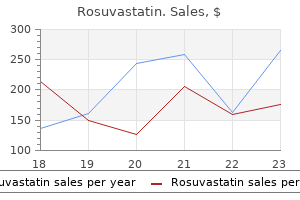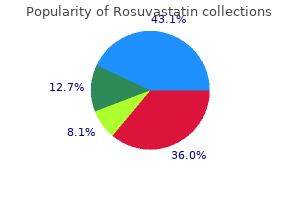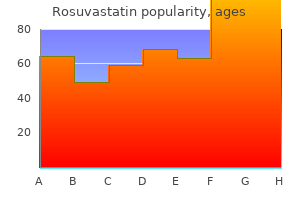Rosuvastatin dosages: 10 mg
Rosuvastatin packs: 30 pills, 60 pills, 90 pills, 120 pills, 180 pills, 270 pills

Order rosuvastatin with amex
In general phrases, tremors abate over time as the levels are allowed to run at a decrease vary. Psychopharmacology Previous therapeutic options for depression have been hampered by the adverse results associated with conventional agents. By comparison, newer antidepressant drugs are more practical and safer in both the overall population and medically unwell sufferers. This various group of compounds possesses distinct pharmacokinetic properties which are unrelated to both the tricyclic/tetracyclic antidepressants or the monoamine oxidase inhibitors. Cataracts develop in roughly Chapter 39 Noninfectious Complications after Kidney Transplantation 579 40% of transplant sufferers and lead to surgery in lots of those afflicted. Diabetic retinopathy is often "burned out" by the time a diabetic involves transplantation. However, for sort I diabetics present process pancreas transplantation, active retinopathy might regress. As visual disturbances after strong organ transplantation could additionally be sight threatening, any new signs are most appropriately evaluated by ophthalmology. Routine ophthalmological examinations are currently beneficial for high-risk patients on an annual basis. Morbidity from posttransplant diabetes, malignancy, and bone illness is substantial. More attention is due to this fact being paid towards stopping and treating these medical complications of transplantation. More effective intervention at the predialysis or dialysis stage also is needed to scale back the burden of morbidity in transplant sufferers. Finally, reduction in long-term immunosuppression should be strongly thought-about in all patients. Accurate estimation of the incidence of recurrence is troublesome for numerous causes. The latter is usually omitted in sufferers presenting with renal dysfunction and atrophic kidneys, and tons of patients are categorized clinically as "chronic glomerulonephritis" or "hypertensive nephrosclerosis. Thus, asymptomatic histological recurrence may be missed within the absence of protocol biopsies. These include the sort and severity of the unique disease, the age at onset, the supply of the donor kidney, and possibly, the immunosuppressive regimen used to stop allograft rejection. In common, disease recurrence in an allograft implies persistence of an extrarenal pathogenetic stimulus. In sure illnesses, modification of the pathogenetic stimulus can stop or delay recurrence of the disease within the allograft. Both male gender and high pretransplantation panel-reactive antibodies levels have been noted to be impartial risk factors for graft loss from recurrent illness. It ought to be emphasized, however, that many research fail to reveal an increased tendency to disease recurrence in recipients of living related grafts. As noted earlier, CsA has been reported to scale back proteinuria by some however not all investigators. Plasma permeability issue exercise was not totally predictive of recurrence, suggesting that different pathogenetic mechanisms must additionally play a task. This in comparability with a 27% induction of remission in a group of 19 historical controls. Some studies have described a lower incidence of recurrence in blacks than in Caucasians. A recent report by Savin and associates demonstrated that the permeability factor binds to and is inactivated by galactose in testing in vitro. The common time from transplantation to recurrence is 10 months, although look as early as one week and as late as 7 years posttransplantation has been reported. The early histological adjustments have been delicate and the clinical manifestations mild with no proteinuria in three of eight cases and low-grade proteinuria within the the rest. The typical clinical presentation of recurrent membranous nephropathy is nephrotic-range proteinuria and graft loss is within the order of 30%. A retrospective examine of 106 patients with biopsy confirmed IgA nephropathy demonstrated related 10-year graft survival compared to 212 sufferers without IgA nephropathy who had been transplanted throughout the identical interval. In one examine, de novo membranous nephropathy developed in four of seven sufferers with a second transplant.
Buy cheap rosuvastatin 10mg online
After the curler has handed, the elastic tubing recoils and refills with blood, ready for the subsequent roller. The greater the number of rollers, the much less pulsatile the circulate, but the greater the danger of hemolysis and injury to the pump phase. Alternatively, the dialysate supply system could be configured with one blood pump and two pressure-controlled blood-line clamps or two pressure-controlled blood pumps that can permit the delivery of dialysis by way of a singleneedle within the vascular access or a single-lumen catheter. An arterial stress monitor should be located proximal to the blood pump and a venous monitor situated distal to the dialyzer. Kinks in the tubing, improper arterial needle place, hypotension, or arterial influx stenosis could cause excessively low arterial pressures. High venous pressures ought to immediate an investigation for blood clotting within the dialyzer, kinking or clotting within the venous blood strains, improperly positioned venous needles, infiltration of a venous needle, or venous outflow stenosis. Excessive positive pressures wherever within the blood Computer Controls As discussed earlier, solute removing during hemodialysis decreases plasma osmolarity, favors fluid shift into the cells, and makes fluid removal harder. Increasing the dialysate sodium focus helps to preserve plasma osmolarity and allows continued fluid elimination,208,209 however may result in increased thirst, extreme weight acquire, and hypertension (see Chapter 24). Theoretically, this sodium modeling offers the benefit of larger hemodynamic stability whereas minimizing thirst and interdialysis hypertension. Altering the filtration rate throughout dialysis theoretically allows time for the blood compartment to refill from the interstitial compartment, resulting in improved hemodynamic stability and less cramping. Monitoring can reduce the amount of blood drawn and permit extra sensitive and frequent assessment of adequacy, management of ultrafiltration, and detection of vascular access stenosis. Anticoagulation Blood clotting during dialysis is a supply of patient blood loss and interferes with solute clearance by reducing the dialyzer floor space. The bolus technique increases nursing time and ends in episodes of over anticoagulation and underanticoagulation. If the affected person is vulnerable to bleeding, lowdose heparin (bolus of 500 to a thousand items adopted by 500 to 750 units/hr) or no anticoagulant may be applicable. Avoiding blood or platelet transfusions via the circuit can be required to minimize clotting. Additional choices are the use of heparin-coated dialyzers or regional citrate anticoagulation,226�228 although heparin-coated dialyzers may be inferior to regional citrate anticoagulation in stopping dialyzer clotting. Monitoring Hematocrit the hematocrit may be measured throughout dialysis, using both a conductivity method246 or an optical technique. Many methods have been described, together with measuring venous pressures and figuring out access recirculation. Angioplasty prompted by a lower in access flow is effective in prolonging fistula survival and preventing thrombosis, however prospective studies of surveillance and angioplasty in arteriovenous grafts have proven blended results (for more details, see Chapter 21). Failure to eliminate the residual syndrome may be associated to insufficient dialysis, failure of dialysis to reproduce one or more features of the native kidney, or issues derived from the dialysis remedy itself. The discovery of dialysis amyloidosis and the next identification of b2-microglobulin because the amyloid precursor characterize a serious advance in the battle to sustain and maintain an affordable quality of life over an extended number of years on hemodialysis. Accumulated evidence reveals more and more strongly assist for using artificial high-flux membranes to prevent clinical progression of dialysis amyloidosis. Other battle fronts in the effort to improve the quality of life include studies of nutrition; the reason for the acute-phase response in dialysis sufferers; the complex interplay between the acute-phase response, nutrition, and atherosclerosis;sixty seven,sixty eight and strategies to forestall each protein and calorie malnutrition. Cardiac hypertrophy, heart failure, sleep patterns, and different quality of life markers additionally show signs of improvement, additional correcting the residual syndrome. Maintaining or bettering work conditions for employees managing hemodialysis patients is justifiable in itself, however is very necessary in dialysis centers as a outcome of a optimistic perspective in the staff promotes higher tolerance of dialysis by the affected person. Many technical advances that embody fail-safe gadgets have decreased but not fully eliminated issues ensuing from the dialysis process itself (see Chapter 24). A uncommon patient experiences an anaphylactoid or allergic reaction through the first few minutes of hemodialysis from publicity to the sterilant ethylene oxide or plasticizers current within the dialyzers or from reactions to the much less biocompatible dialyzers (see Chapter 24). Bioincompatible dialyzers activate complement, cytokines, leukocytes, and platelets, inflicting chest ache, shortness of breath, and sludging of leukocytes and platelets within the pulmonary vasculature. Fever during dialysis may be caused by bacterial contamination or endotoxin within the supply water or dialysate and by access infection. Shear forces induced by rapid blood move in dialysis catheters can launch bacterial merchandise and biofilm from throughout the catheter lumens, inflicting a septic shock like syndrome that can be fatal. Potentially life-threatening problems similar to hemolysis and air embolism are rare however should be acknowledged promptly. Symptoms of hemolysis and air embolism could also be nonspecific and include chest pain or tightness and shortness of breath, signs that are additionally observed with reactions to the dialyzer, the sterilant, or endotoxin.

Buy cheap rosuvastatin 10mg on line
Linear IgG deposition had disappeared in one after 12 months, but persisted within the second patient 5 years later. Success has been claimed with early use of cyclophosphamide, plasmapheresis, steroids, and dipyridamole;102,104 nevertheless, others dispute the long-term effectiveness of therapy. However, only 25% of those patients have clinical manifestations of recurrent disease, and graft loss is uncommon. Diabetic kidney disease in a transplant could additionally be recurrent or, less generally, de novo disease. However, the classical histological modifications of diabetic nephropathy, corresponding to glomerular basement membrane thickening, mesangial enlargement, and arteriolar hyaline deposition, may been seen inside 2 to four years of transplantation. Most of the data on disease recurrence derives from case stories and small case collection with reported recurrence charges of up to 20%; nonetheless, recurrence is a rare cause of graft failure. It is in all probability going that immunosuppression administered to prevent graft rejection helps prevent disease relapse. Indeed, the information by Gera and associates would counsel that modern immunosuppression may be more protecting in opposition to relapse. Following kidney transplantation there appears to be a discount in lupus exercise. The price of recurrence of lupus nephritis postrenal transplantation varies from 2% to 9%. The pathological hallmark of the disease is deposition of IgA in the glomerular mesangium and blood vessels of the dermis and intestine. The incidence of histological recurrence following renal transplantation is approximately 50%. Active proliferative nephritis with or with out extrarenal manifestations has been reported in as much as 20% of circumstances. Both renal and extrarenal manifestations can recur several years following Chapter 40 Recurrent and De Novo Renal Diseases After Kidney Transplantation 587 nephropathy (30 months vs. A small case sequence 588 Section V Transplantation about the consequence of transplantation in these disorders, because the data obtainable is proscribed to case reports. Nevertheless, case reviews have proven a low rate of recurrence of forged nephropathy that appeared to have little antagonistic affect on graft perform. Early reviews suggested that bilateral nephrectomy on the time of transplantation improves consequence. However such recommendations are rarely essential given enhancements in antihypertensive therapy. In a recent retrospective research of thirteen sufferers with 16 renal grafts, graft survival at 1 and 5 years was 56% and 56%; however, the most important explanation for graft loss was demise with a functioning graft. Despite the chance of recurrence and the comparatively excessive mortality fee, patients with amyloidosis ought to nonetheless be thought-about for transplantation, as a end result of survival appears superior with renal transplantation in comparison with maintenance dialysis. From the small number of instances reported, it seems that fibril deposition recurs in a minimum of 50% of patients; nevertheless, the decline in renal operate in allografts is normally slower than in native kidneys, and a lot of patients preserve passable function over years. It is tough to make sturdy inferences Oxalosis or primary hyperoxaluria type 1 is an autosomal recessive disease, which ends from deficiency of hepatic peroxisomal alanine glyoxylate aminotransferase. Absence of this enzyme causes oxalate overproduction and recurrent calcium oxalate nephrolithiasis and nephrocalcinosis. Because the metabolic defect is confined to the liver, combined liver and kidney transplantation can restore normal oxalate levels and is considered the therapy of choice for children with oxalosis complicated by progressive renal Chapter 40 Recurrent and De Novo Renal Diseases After Kidney Transplantation 589 disease and proof of marked tissue oxalate deposition. Since 1984 greater than a hundred such mixed procedures have been performed with a 5 year actuarial survival of 80% for sufferers and 71% for liver grafts with steady renal function. Administration of pyridoxine, a coenzyme that features within the conversion of glyoxylate to glycine and thereby decreases the glyoxylate pool, has also been really helpful to keep graft operate. However, biopsy studies have demonstrated recurrence of Fabry illness manifested by Fabry inclusions within the vascular endothelium and deposition of glycolipid in tubular epithelial and endothelial cells as early as six months posttransplantation. Secondary focal sclerosis has been described in transplanted kidneys, presumably a consequence of nephron loss because of intrarenal sickling. Crises appear to be more common following transplantation in homozygotes than in heterozygotes. Cystinosis Cystinosis is an autosomal recessive disorder that outcomes from faulty transport of cystine from lysosome to cytosol. Lysosomal accumulation of cystine in the renal interstitium ultimately causes interstitial fibrosis, glomerular sclerosis, and renal failure. Renal transplantation is very profitable and is the preferred mode of therapy for children with this situation.


Cheap 10mg rosuvastatin with amex
A latest report of ultimate adult peak in pediatric renal transplant recipients suggests that the present improvement in ultimate grownup height posttransplantation is more associated to enhancing peak deficits previous to transplantation than to any net features achieved after transplantation. For example, prophylactic native nephrectomy and reversal of protein wasting and malnutrition improves the 596 Section V Transplantation donor renal vein is anastomosed to the recipient vena cava in an end-to-side method. Hemodynamic research recommend that the cardiac output of infants should double to perfuse the grownup donor kidney adequately. Unlike the transperitoneal method necessary in youthful kids, this transplant is extraperitoneal, with the renal vein anastomosed to the frequent iliac or the exterior iliac vein. The ureterovesicular anastomosis is performed utilizing the strategies described earlier. In common, the incidence of urinary tract infection and different complications is greater in these recipients; nonetheless, their course is generally no worse than pediatric recipients with out urological abnormalities. For small children, lower than 15 kg, the transplant is carried out by way of a midline incision, and the massive abdominal vessels are used. After ligating and dividing the lumbar branches, the iliac arteries and the inferior mesenteric are encircled. Next the inferior vena cava is mobilized from the left renal vein to the iliac veins. The graft is intraperitoneal and occupies most of the right facet of the peritoneal house. Pediatric Renal Transplantation 597 Delayed Graft Function A well-functioning kidney graft ought to lead to regular renal operate within 2 to 3 days. A dreaded event, this condition is irreversible in most cases and necessitates removal of the graft. Graft thrombosis must be suspected in instances the place there was instant operate adopted by the development of oligoanuria. Since the finish result of graft thrombosis is uniformly dismal, quite a few research have been performed in an attempt to understand and anticipate this complication. The use of antibody induction therapy, the use of donors older than 5 years of age, and growing recipient age had been factors that decreased the danger of thrombosis. Although normally a significant cause of instant graft nonfunction, it might be seen afterward in the course and has been recorded to occur as late as 15 days posttransplantation following preliminary engraftment and performance. Note the good perfusion, followed by little excretion and "wash out" of the tracer from the graft. Note the photopenic area in the proper stomach, indicating thrombosis of the graft with no perfusion. An ultrasound or radionuclide scan with a furosemide washout enables the clinician to establish this prognosis. Obstruction can be as a end result of kinking of the ureter, to edema or blockage of the implantation site of the ureter or to development of a lymphocele. A extra ominous explanation for quick nonfunction is the rare case of urinary leak due to disintegration of the distal ureter or rupture of the bladder. The appearance of the tracer within the peritoneal cavity or in the scrotal, vulvar, or inguinal area clinches the prognosis and immediate surgical correction is necessary. At least one of these trials resulted in glorious long-term graft perform, however had a excessive fee of early acute rejections. Note the good perfusion of the graft and the speedy focus and excretion from the kidney. Tracer, nevertheless, quickly accumulates in the best decrease quadrant, exterior of the bladder. The authentic illness that triggered the native kidneys to fail may also have an effect on the transplanted kidney. In a evaluation of 8777 rejection episodes over a 15-year study, there have been, on average, 0. A exceptional decrease in the incidence of acute rejection has occurred over the past 20 years (Table 41-3).

Discount rosuvastatin online
For causes that embrace patient preference, surgeon preference, and doubtless marketing strategy, laparoscopic nephrectomy has become the donor nephrectomy methodology of alternative in the larger U. There is a few proof that the perceived advantages of laparoscopic nephrectomy have contributed to the increase in donation rates. However, the charges of early allograft dysfunction could also be higher with this technique due to larger intraabdominal pressures required during the procedure, longer warm ischemia times, much less expertise with the approach, a studying curve, and more manipulation of the renal vessels. One current metaanalysis did present equivalent recipient outcomes with both retrieval technique. However, older donors, similar to parents, are sometimes most popular in case a subsequent transplant might be required. The more necessary concern is whether or not there are any medical contraindications (the prevalence of hypertension and type 2 diabetes mellitus, for example, increases with age). The short-term dangers are these related to the surgery itself, together with dying, thrombosis, myocardial infarction, and wound an infection. Because donors potential, however, that a publication bias exists, with poorer outcomes associated with the newer approach not being reported. Furthermore, it is extremely possible that recent donors may have higher charges of nephrectomy-related issues in comparability with these from 20 years in the past as a result of weight problems and type 2 diabetes mellitus are now extra frequent in the common population (and will probably turn into more common in present donors), and some facilities are actually allowing extra "medically complex" donors to donate than earlier than. One well-performed European examine discovered that the survival of donors exceeded that of the overall population- presumably largely because only healthy individuals are allowed to donate. When donors had been compared to siblings, a similarly excessive incidence of hypertension was found in each. As for different long-term complications, in a subgroup of the preceding study who underwent further evaluation (n � 255), 87. The physician must additionally totally clarify the short- and long-term penalties of donation. The historical past, examination, and tests ought to focus on excluding contraindications to donation. Occasionally, disagreements will come up whereby the evaluating physician will advise against donation, however the affected person will still wish to donate "regardless of the threat. One possibility is to evaluate the affected person again after 3�6 months of lifestyle modification, which has shown to be effective in reducing the chance of progression to diabetes. Of course, to be effective, way of life modification must be continued after donation. It is sobering to observe that the estimated lifetime chance of growing diabetes mellitus if born within the United States in 2000 was about one in three. If the potential donor is over age 30, the absence of cysts on a rigorously performed ultrasound nearly excludes the prognosis. Alport syndrome is a genetically heterogeneous illness with X-linked, autosomal recessive and autosomal dominant variants. Male siblings over 20 years of age are most unlikely to have the disease if hematuria is absent. Sisters of affected male recipients with X-linked illnesses have a 50% chance of being carriers; a small p.c of such females carrying the irregular gene do develop renal failure. Thus, feminine heterozygotes (identified as having hematuria however normal renal function) should only be allowed to donate, if at all after detailed consultations with a nephrologist and geneticist. Potential donors ought to be warned that often imaging will reveal renal or different abnormalities which will delay or prevent protected donation. Not surprisingly, when the recipient has diabetic nephropathy because of kind 2 diabetes mellitus, the danger of related donors creating diabetes later in life is a significant concern. Although little is called to whether single-kidney standing would speed up the progression of diabetic nephropathy, it seems prudent to keep away from donation in those thought to be at high danger of creating kind 2 diabetes mellitus later in life. In addition to family historical past (especially first-degree relative) of type 2 diabetes mellitus, other components that can increase risk are weight problems, increasing age, nonwhite ethnicity, and a history of gestational diabetes. All patients with a family historical past of sort 2 diabetes mellitus ought to have a glucose tolerance test; if this fits the criteria for diabetes mellitus, then donation is prohibited. Any potential donor with hypertension should have an echocardiogram (to assess left ventricular mass), urine protein studies (see following), and a proper ophthalmological assessment (for hypertensive retinal changes). Hypertension with any evidence of end organ damage is an absolute contraindication to donation. Some facilities use iothalamate clearance routinely or only where the creatinine clearance is low or low-normal.
Cheap rosuvastatin online visa
First, the utilization of embryonic stem cells engenders moral considerations, as a end result of isolation of these cells is usually associated with destruction of the early embryos from which they originate. Second, embryonic stem cells and indeed all pluripotent stem cells can and often do type teratomas and teratocarcinomas after implantation into mature people. These problems increase interest in applied sciences that could be used to generate pluripotent stem cells from the cells of mature people. Cloning by nuclear switch can generate a whole particular person, a process called reproductive cloning, or a tissue or organ, a process known as therapeutic cloning. One benefit of therapeutic cloning is that it generates cells with the identical histocompatibility antigens as the individual from whom the nucleus is obtained (except for mitochondrial antigens, which derive from the oocyte). Another benefit is that the cloned cells, like embryonic stem cells, can become any tissue. Using human embryonic cells for cloning mature cells would face the identical ethical barriers as utilizing human embryonic stem cells, because the immature cells could be obtained by destroying human embryos; nonetheless, cloning has been accomplished using embryonic cells from completely different species. Hence immunosuppression might be wanted or the graft may fail over a time frame. The most promising strategy to producing pluripotent stem cells includes reprogramming of the cells by expressing primitive genes. Generating pluripotent stem cells on this means would overcome most ethical hurdles and would guarantee that the pluripotent cells, and their progeny can be absolutely histocompatible with the individual from which the reprogrammed cells had been obtained. However, reprogramming cells by transfection would increase concerns in regards to the potential growth of tumors. This concern could be addressed partly if reprogramming components could presumably be delivered as proteins somewhat than as genes encoding them. Adult stem cells can migrate by way of the blood and take up residence in injured tissues. However, effective software of stem cells for regeneration could require overcoming obstacles nonetheless unknown that prevent the natural stem cells of the patient from regenerating the diseased kidney in the first place. The generating of a whole organ such as the kidney by grownup stem cells is much less feasible than doing so with embryonic stem cells, as a outcome of Emerging Strategies in Kidney Transplantation 633 adult stem cells appear to have less capability to proliferate and differentiate. However, grownup stem cells would possibly someday be used to present metabolic functions, as mentioned earlier. Stem Cells and Regeneration of the Kidney Given the eye devoted to the promise of stem cells, one may think that pluripotent stem cells and perhaps mature stem cells will sometime be used to regenerate diseased or injured kidneys. As discussed later, isolated fetal cells and organ rudiments do have the capacity to kind a complete organ, a process known as organogenesis, but making less differentiated, much less dedicated cells behave on this method would seem to be a challenge. One application of pluripotent stem cells that may be thought of is that of providing whatever metabolic functions are missing in those with delicate renal insufficiency. Indeed, one latest report claims to have generated kidney like devices utilizing cloned cells of cattle. Tissue Engineering While embryonic stem cells or cloned cells have the capacity to differentiate into any sort of cell and contribute to formation of mature tissues and organs, they might not be in a position to type intact organs, as discussed earlier. Organogenesis, as such, requires cues from complicated cell-cell and cell-matrix interactions that is probably not easily recapitulated exterior the embryo. One approach to deliver some of these cues is through tissue engineering, the use of scaffolds consisting of artificial or biological polymers, to coax growth and growth. Organogenesis Organogenesis (de novo organ formation) could be used to generate organs for transplantation. Nephrogenic mesenchyme cultured beneath appropriate conditions has been shown to become kidney like constructions in vitro. Hence we predict a consideration of technologies for the near future is affordable and prudent. This consideration helps to determine which technologies must be improved and which new technologies could additionally be wanted. Such people may be candidates for an engineered organ, as mentioned later; however, on this case, temporary renal alternative would be needed, and an allograft or even a xenograft might serve that objective. Someday, xenografts might be used as a temporizing therapy until a histocompatible organ alternative could be produced. The steps embrace generation of pluripotent stem cells from the person needing remedy. The stem cells may be used to fashion a tool;103 however, we consider the better solution may be to generate nephrogenic mesenchyme, perhaps in a xenogeneic host as described above, after which use it for organogenesis within the affected person. Some renal ailments might be handled by transplantation of cells that present a hormone or other substance deficient in those with continual kidney illness.
Buy rosuvastatin 10mg on-line
Often these patients could be treated conservatively with medical remedy (including anticoagulation), but there are times when revascularization is important. As in any instance of coronary artery dissection, percutaneous coronary intervention (and stenting) is more difficult and dangerous in peripartum patients with coronary artery dissection. However, medical administration may be tough because of the risk of hemorrhage and teratogenesis with antiplatelets and anticoagulants. The danger of fetal dying is usually associated with maternal dying, which emphasizes the significance of optimizing maternal well being. Food and Drug Administration categorizes medication in accordance with their potential to cause start defects, based on knowledge from human and animal research. The classes vary from class A drugs (no documented fetal risks) to class X medicine (contraindicated in part or all of being pregnant as a outcome of proven teratogenicity). Very few cardiovascular medication are class B (animal studies recommend threat, but outcomes are unconfirmed in controlled human studies). The majority of cardiovascular drugs presently in use are literally class C (animal studies have demonstrated opposed fetal effects, however no managed human studies are available). Finally, class D medicine demonstrate some proof of human fetal risk, however the advantages from use throughout being pregnant may be acceptable regardless of the chance. In basic, if pharmacologic therapy is required, drugs which have been in use for longer durations prescribed on the lowest potential dosages are beneficial. FutureDireCtions the increased survival fee of women with congenital coronary heart illness mixed with the trend towards delaying childbearing will continue to enhance the probability that the providers of well being care to pregnant women will manage complicated heart problems. Ideally, a multidisciplinary approach to these patients at a tertiary care center is recommended to optimize outcomes for mom and child and to present information for treatment of other like people. As pregnant women are incessantly excluded from clinical trials, the proof for the administration of heart problems throughout pregnancy is modest and mostly based on case collection and registries. Since commonplace therapies are extrapolated from research in additional generalized populations, additional investigation is needed in this specialised population. Compares the epidemiology of traditionally outlined peripartum cardiomyopathy with pregnancy-associated cardiomyopathy of earlier onset. Gives the consensus views arising from the 51st Study Group: Heart Disease and Pregnancy (2006). Reviews frequent congenital coronary heart diseases in relationship to dangers during pregnancy. Ideally, multidisciplinary antenatal discussions must be shared amongst obstetricians, cardiologists, and primary care providers. Avoiding Treatment Errors Because medication are hardly ever tested in pregnant ladies, safety data on the overwhelming majority of pharmaceuticals on this inhabitants is lacking. Most cardiovascular drugs cross the placenta and are additionally secreted in breast milk. Provides present classification of and recommendations for treatment of hypertension during pregnancy based on consensus opinion. Provides present classification of and suggestions for remedy of peripartum cardiomyopathy based mostly on consensus opinion. Task Force on the Management of Cardiovascular Diseases during Pregnancy of the European Society of Cardiology. Provides present recommendations for remedy of coronary heart illness during being pregnant based on consensus opinion. Tan 59 enescence is a elementary life process that outcomes from a posh mixture of age-related physiologic adjustments together with adjustments in cardio respiration, increased oxidative metabolism and stress, genetic and cellular injury as a outcome of the accumulation of mutations, and lifelong exposure to various environmental stresses. Together these events outpace endogenous surveillance and restore mechanisms and/or provoke compensatory responses that turn into maladaptive and trigger mobile and organ dysfunction. Although its histologic features differ little throughout the age spectrum, the presence and severity of atherosclerosis markedly increase with growing older. Chronic deconditioning, despair, and different confounding comorbidities in elderly individuals add one more layer of complexity in discerning which modifications are attributable to age and which to surroundings (Table 59-1). This chapter focuses on age-related changes in the cardiovascular system and considers strategies which will lower the chance of death and incapacity from cardiovascular illnesses in elderly individuals. S stress on the myocardium that results from the persistent increase in peripheral vascular resistance that also occurs with growing older.

Buy rosuvastatin 10mg
Different forms of renal alternative remedy do, nevertheless, clear solutes at totally different charges based mostly on traits together with molecular size, protein-binding, and sequestration within cells or different body compartments. The demonstration that different therapies have totally different effects on some characteristic of uremic illness might subsequently reveal the properties of the accountable toxin. The Original Middle-Molecule Hypothesis the suggestion that the nature of uremic toxins could be deduced by comparing the impact of different renal replacement methods was first advanced by Scribner and Babb and their colleagues. Treatment with these membranes wakened sufferers from coma, relieved vomiting, and partially reversed different uremic signs. This supplied evidence, which remains convincing, that some necessary uremic toxins are small. But Scribner and his associates have been impressed that patients on peritoneal dialysis were healthier than sufferers on hemodialysis who had the same urea and creatinine concentrations. These observations led them to conclude that important toxins were larger than 300 D as a result of, as in comparability with up to date hemodialysis membranes, the peritoneal membrane afforded higher relative permeability in this dimension range, and because rising the dialysis length was anticipated to reduce the concentration of huge molecules more than the focus of creatinine and urea. Based on their further impression that no additional profit was obtained utilizing membranes that offered superior clearance for solutes with dimension higher than 2000 D, they concluded that some essential toxins had been "center molecules" with molecular weight larger than 300 D but less than 2000 D. When expressed as multiples of normal, levels of these compounds are subsequently much larger than levels of unbound solutes like urea and creatinine in hemodialysis sufferers. The decreased drug binding noticed in uremic plasma has so far not been fully replicated by addition of recognized uremic solutes to regular plasma, and our current listing of the protein-bound solutes that accumulate in uremia is undoubtedly incomplete. The normal kidney achieves excessive clearance rates for a lot of protein-bound solutes by lively tubular secretion. Presumably, the combination of protein-binding and tubular secretion represents an evolutionary adaptation that allows for excretion of poisonous molecules while preserving their concentrations within the extracellular fluid very low. Mathematical fashions predict that hemofiltration, which removes massive solutes more effectively than routine hemodialysis, removes protein-bound Large Solutes-the Changing Definition of "Middle Molecules" Only equivocal evidence was obtained during the 1970s that increasing the clearance of solutes with molecular weight between 350 D and 2000 D improved the well being of uremic patients. Although the term "center molecules" remains in use, its which means has steadily shifted to embody larger solutes. The 2003 report of the European Uremic Toxin Work Group1 thus outlined center molecules as having a size higher than 500 D and fewer than 60,000 D, which is nearly the scale of albumin. In practice, the adoption of latest membrane materials, which was in part a response to the original "center molecule speculation," has ended investigation of the relative toxicity of solutes that fall in different parts of the scale range less than a thousand D. The query of whether or not solutes with molecular weight higher than 1000 D exert toxic effects remains beneath investigation. Henderson and colleagues133 showed that such solutes can Chapter 18 solutes less successfully. Addition of a sorbent to the dialysate improves the clearance of protein-bound solutes. The maximal effect of addition of a sorbent is equal to an unlimited increase in dialysate circulate. When this occurs, intermittent dialysis therapy will be followed by a rebound within the plasma solute focus towards predialysis levels. The effect of sequestration on the elimination of urea, which is mostly used to assess dialysis adequacy, is modest. Studies demonstrating sequestration of creatinine, uric acid, and a number of other guanidines are consistent with this assumption, however the habits of other solutes has not been examined. When treatment is intermittent, the removal of sequestered as in comparison with freely equilibrating solutes could be elevated by lengthening the treatment whereas lowering the plasma clearance. It has been advised that this effect could also be accountable partly for the distinctive results reported with gradual thrice weekly hemodialysis. Dialysis patients have turn into comatose following ingestion of star fruit, a member of the Oxalidaceae family. Uremic solutes made by colonic micro organism include methylamines and a few indoles and phenols. To the extent that uremia is brought on by accumulation of organic solutes, knocking out these transporters can be anticipated to reproduce uremic signs. To date, knocking out both the natural cation transporters 1 and a pair of has been proven to abolish tubular secretion of organic cations without causing detectable sickness. Effects of Diet and Gastrointestinal Function It may be potential to establish uremic toxins by comparing the consequences of different diets and different renal alternative therapies. Moreover, as is the case with uremic solute retention, the modifications which might be easiest to measure will not be crucial contributors to illness.
References
- Roccatello D, Sciascia S, Rossi D, et al. Long-term effects of rituximab added to cyclophosphamide in refractory patients with vasculitis. Am J Nephrol. 2011;34:175-180.
- Katon WJ. Clinical and health services relationships between major depression, depressive symptoms, and general medical illness. Biol Psychiatry 2003;54: 216-26.
- Curran MA, Montalvo W, Yagita H, et al. PD-1 and CTLA-4 combination blockade expands infiltrating T cells and reduces regulatory T and myeloid cells within B16 melanoma tumors. Proc Natl Acad Sci U S A 2010;107(9):4275-4280.
- Guigui P, Benoist M, Delecourt C, Delhoume J, Deburge A. Motor deficit in lumbar spinal stenosis: a retrospective study of a series of 50 patients. J Spinal Disord. 1998; 11(4):238-288.
- Slovak ML, Kopecky KJ, Cassileth PA, et al. Karyotypic analysis predicts outcome of preremission and postremission therapy in adult acute myeloid leukemia: a Southwest Oncology Group/Eastern Cooperative Oncology Group study. Blood 2000;96(13):4075-4083.






